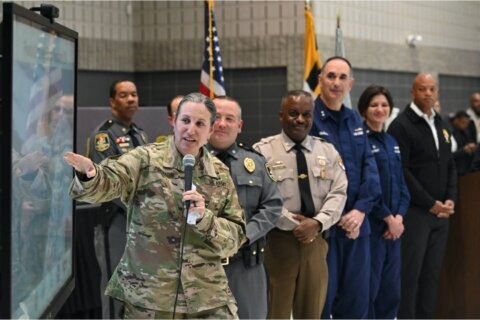The Baltimore Sun published an apology Saturday regarding a history of racism that dates back nearly two centuries.
In a piece credited to the Sun’s editorial board, the authors stated that the Sun, over its 185-year history, had “sharpened, preserved and furthered the structural racism that still subjugates Black Marylanders in our communities today.”
WTOP contacted the Sun to ask what prompted the apology. Tricia Bishop, the Sun’s director of opinion content, said the Sun preferred that the editorial “speak for itself,” but provided a statement from the Sun’s publisher/executive editor, Trif Alatzas:
“We ask that people read the editorial, which apologizes for our institution’s shortcomings in our 185-year history. Like other institutions in this community, we have a storied history. But as members of our staff studied The Sun’s past from its origins through today, it was clear we needed to acknowledge these deficiencies. We thank members of our diversity committee and editorial board who worked for more than a year to document this piece. We believe the apology is overdue. We invite readers to offer us feedback so that we can do better. We are committed to doing so.”
For more than a decade, newspapers have periodically done some self-assessments regarding their coverage of race and their hiring and promotion practices, said Kathy Best, director of the Howard Center for Investigative Journalism at the University of Maryland’s Philip Merrill College of Journalism.
More newspapers, Best said, looked into their own histories after the murder of George Floyd and the spread of Black Lives Matter protests. And much of that was due to the staff of those newspapers, she said. Newsroom employees “were asking questions and demanding … greater accountability around diversity and equity and inclusion.”
That led to some outlets — such as the Los Angeles Times and the Kansas City Star — to write extensively about the history of racism in their pages, Best said.
Asked if The Baltimore Sun’s apology is enough, Best said she didn’t want to offer her own opinion. But she did say: “I’ve done a lot of reading about whether it’s enough to offer just an apology, and the consensus that I’ve read is that no, it’s not.
“It’s a start. It’s a good start.”
Citing experts, Best said what needs to follow is a conversation with the community by putting in place actual targets that can be met for hiring or for increasing the diversity of coverage — and it needs to be followed by actions to make a difference.
Best’s students are also pushing for change in what gets covered, how it gets covered and who is asked to go out on a particular assignment.
Change has been coming over time, Best said. Before she left her post as the editor at The Seattle Times — which Best said had a “pretty good” history of embracing diversity in the newsroom — she met with the paper’s younger reporters and staff members.
Students pushed back on the paper’s track record, Best said. “Well that’s yesterday. What are you doing now, what are you doing tomorrow?” were some of the questions the students asked, Best said.
Newsrooms, she said, have given a lot of “lip service” to diversity.
To have a newsroom that reflects the demographic that it covers, Best said there needs to be change.
“They have to make those newsrooms the kind of places where diverse journalists want to work. And those young journalists are not being shy anymore. They’re asking hard questions.”
A project at the Howard Center for Investigative Journalism grew out of the work done by Washington Post reporter DeNeen Brown, who is an associate professor at the University of Maryland’s journalism school.
Brown wrote about the history of the Tulsa, Oklahoma, race riot. “And in covering that story for the Post, she was struck by the headlines that ran in the Tulsa newspapers that were essentially encouraging people to attack black citizens of Tulsa,” Best said.
That led to an in-depth examination of coverage of race-based violence and lynchings by white-owned newspapers called “Printing Hate.”
Best said the students from the University of Maryland, Hampton University, Howard University, Morehouse College, Morgan State University and North Carolina Agricultural and Technical State University were “stunned by what they read and angered by what they read.”








